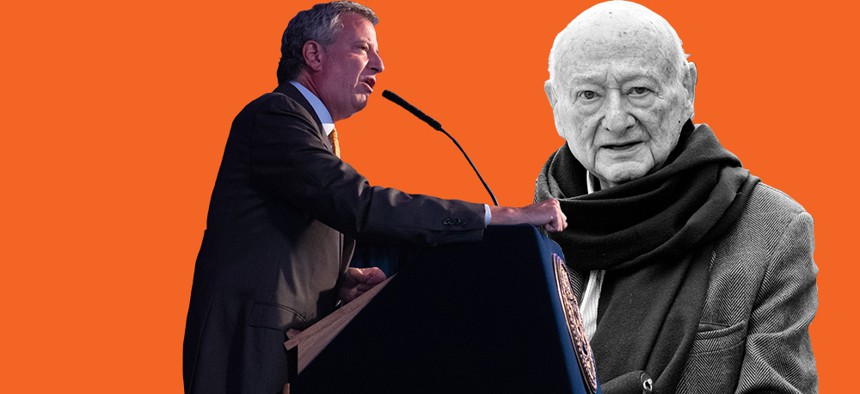New York City’s affordable housing push leaves out key group — homeless individuals and families
A look at de Blasio's claim of record progress on affordable housing doesn't hold up to scrutiny.

New York City mayors Bill de Blasio and Ed Koch Michael Appleton/Mayoral Photography Office and Shutterstock
Once again, New York City Mayor Bill de Blasio is touting record affordable housing created by his administration. A press release from his office two weeks ago trumpeted that Fiscal Year 2018 was the “largest year for affordable housing production in city’s history.”
But a look behind the numbers shows that a strikingly small number of these affordable homes will be given to those who need them most: the 62,000 New Yorkers, including 22,500 children, who are sleeping in city shelters tonight.
If this trajectory holds, New York City will spend billions of dollars on the largest affordable housing program by any city in American history, only to emerge from it still dealing with levels of homelessness not seen since the Great Depression.
"De Blasio is settling for half-measures, failing to use the most important tool in his toolbox: actually building homes for homeless people."
So let’s unpack the math. That way we can see how homeless families can better fit into the city’s affordable housing push.
De Blasio’s Housing New York 2.0 plan will create or preserve 300,000 units of affordable housing by 2026. Since the plan launched, 109,767 units have been preserved or financed for construction. Fiscal Year 2018 saw 32,116 units created or preserved, an increase of about 33 percent from the year before. In response to criticism that too few of these units were affordable to working class and poor New Yorkers, FY 2018 also saw more units set aside for those making below 80 percent of area median income.
That is the good news.
But despite the substantial increase in housing production last year, the number of units set aside for homeless New Yorkers actually fell to 2,318 from over 2,600 the previous fiscal year. And it could be lower still in the years to come. Of the 300,000 units the city is aiming to create or preserve, just 5 percent will be made available for homeless households.
It doesn’t have to be this way. A broad coalition of elected officials, advocates, service providers and homeless New Yorkers have come together for the House Our Future NY campaign to urge the Mayor to set aside 30,000 units (10 percent) of his Housing New York 2.0 plan – including 24,000 units of newly built housing – for homeless households. With the capital the city has already committed and new term sheets for developers, the city already has the tools it needs to do this.
A commitment like this is not without precedent. Mayor Ed Koch, who instituted what was then the largest affordable housing program in city history, devoted more than 10 percent of the units in his 10-year plan to homeless families – at a time when there were only about a third as many people in shelters as there are today. His plan was explicitly guided by a desire to reduce homelessness and address the housing crisis where it was most severe – at the lowest end of the income spectrum.
Achieving this level again would, in combination with the city’s housing voucher programs and critical efforts to prevent eviction and homelessness, set New York City on a clear path to meaningfully reducing homelessness for the first time in nearly 15 years.
Mayor de Blasio recently claimed that his administration “has used every tool available to fight the affordability crisis in New York City.” But for those most in need of a home, this is simply not true. De Blasio is settling for half-measures, failing to use the most important tool in his toolbox: actually building homes for homeless people. He is ignoring the very real evidence that shows severe housing cost burdens for the lowest-income households in favor of a plan that falsely asserts that housing is unaffordable to those at all income levels. Most strikingly, he has been unresponsive to the repeated pleas of elected officials, clergy, advocates, and people who are homeless – including children – asking him to revise his plan to meet the true need.
Designating at least 30,000 apartments, including no fewer than 24,000 created through new construction, for homeless households would build on the precedent set by Koch’s plan and provide a once-in-a-generation opportunity for de Blasio to leave a worthy legacy and finally reverse the city’s decades-old homelessness crisis.
He has the tools to do this. He just has to use them.
